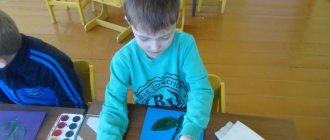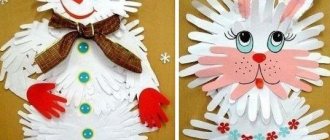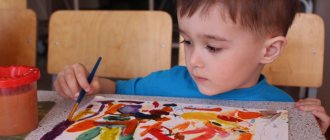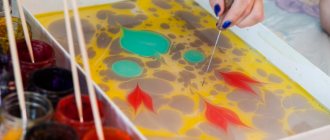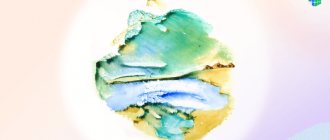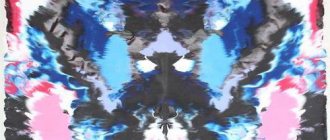Scratch board for children: DIY engraving craft. We will tell you about the technique of performing grattage step by step, works and drawings in this technique: grattage fireworks, landscape, space.
Scratching is one of the types of graphics based on making a quick silhouette sketch by scratching. Non-standard drawing techniques are interesting to all children, regardless of age. The only difference is that we have to help the kids prepare the source material, and the older ones can do everything on their own, since the technique of performing grattage for children is quite simple.
The word grattage comes from the French Gratter - to scrape, scratch. This is a well-known method of making a drawing by scratching paper or cardboard filled with ink or black gouache with a sharp tool. Another name for the technique is waxography , sometimes also called scratching.
All the steps in preparing a worksheet for work are interesting and useful in that they instill in the child a sense of consistency, attention, and perseverance. Drawing on a prepared dark sheet is generally like magic : the child will be amazed to see how bright, contrasting lines and strokes appear on a black background.
That is why the most popular motifs in the grattage technique for children are those that are always performed on a dark background: space, a rocket, a night landscape, festive fireworks.
Manufacturers call ready-made scratching kits scratch cards and engravings.
DIY engraving
Drawing is considered an engraving, because the image is obtained by applying strokes without the help of paints, although it would be more accurate to call this technique an imitation of engraving .
On colored cardboard
The simplest scratch paper can be made with your own hands on ordinary colored cardboard. An economical and colorful option is scratch paper on colored cardboard, for example, bright boxes, notebook or magazine covers, etc.
You will need: any colored cardboard, black gouache or acrylic paint, dishwashing liquid, a mixing glass, a candle, a stick for scratching the design.
- Mix cardboard paint: Add 6 teaspoons black paint and 1 teaspoon dishwashing liquid to a glass and stir gently until smooth.
- Take a regular candle and carefully wipe the colored paper pages with wax. The cardboard should be completely covered with a thin layer of wax.
- Take a brush and paint the resulting wax paper with the resulting black mixture. It's best to stock up on printmaking paper so you'll have plenty of material to experiment with!
Scratch stick
Take any stick with a sharp end, such as a wooden skewer. By decorating the stick with washi tape and a wooden bead, the tool becomes a truly chic etching stick.
You can find another scratching device. Even a dry marker works well.
Engraving with wax crayons
- Cover the construction paper with splashes of color using strokes of wax crayons.
- Paint the entire painting black using a soft brush. Not too thick, but not too thin either. If the colors are still showing through after 1 coat, you will need a second coat.
Scratching: history and features of technology
Scratching, or waxography, is a technique of scratching an image on a specially prepared base. It came to Russia from France a hundred years ago and immediately became popular among artists, because in the art of that time everything new, unusual, even fantastic was highly valued. Even earlier, in the 13th century, the sgraffito technique was known in Italy. The craftsmen applied several layers of plaster of different colors to the wall, and then, using special scrapers, scratched images into them so that the lower ones appeared from under the upper levels, forming beautiful paintings that covered the entire wall. It is sgraffito that is considered the predecessor of grattography.
The secret of grattage paintings is not in the paints and brushes, but in how the background was prepared and what patterns were scratched on it. Accordingly, the artist’s tools differ from the usual ones. For creativity you will need:
- a sheet of thick paper or cardboard;
- paraffin (candle), wax crayons or oil pastels;
- black ink or gouache (if desired, you can use dark blue, purple, brown);
- liquid soap;
- sponge or wide soft brush;
- a sharp tool for scratching - a special stick, a toothpick, a non-writing pen.
If your child was given a set with a ready-made scratch paper coloring book, do not throw away the plastic pen included in the set after using it. This pointed stick is also useful for home arts.
For preschoolers, different ways of making drawings are suitable, which can be used within the same step-by-step instructions:
- Preparing the work surface and tools. Cardboard or thick drawing paper must be secured to the table, for example, with tape.
- Primer, first stage. Classic grattage assumes the presence of only two colors - black and white. But scratching a design on a black background becomes like real magic if you make the base colored. To do this, you need to completely paint over the sheet with random spots of the selected color scheme. This can be done either with ordinary pencils, and then you will need to carefully rub the entire surface with a candle, or with wax or pastel crayons. Feel free to entrust this operation to your child.
- Primer, second stage. Now the sheet needs to be evenly covered with ink or gouache using the selected tool. Here you will need the help of an adult. Experts in grattography techniques at master classes recommend adding a drop of liquid soap or dishwashing detergent to the paint first so that it goes on smoother.
- Drawing a contour. When the primer is completely dry, you need to mark the boundaries of the future drawing and its largest details, for example, with a thin pencil line.
- Detailing. The most interesting part, for the sake of which everything was started! Using a sharp tool, you need to scratch out thin or wide lines and strokes to gradually achieve the desired design.
Handle the base very carefully: fingerprints and other minor damage will be clearly visible on it. To protect the primer, place a sheet of clean paper under your hand.
Scratch board for children
Festive fireworks - flashes of color on a coal-black sky - are an ideal theme for creative work using the grattage technique.
Night landscapes also look spectacular.
Animals, insects and fish, and almost any motif look beautiful in this technique.
A way to depict a drawing for any age
Any child can learn to draw, which depends little on his natural capabilities and abilities. First of all, you need to approach the learning process correctly. This is the task of adults: to develop the child’s creative potential. If you want to interest a novice artist, introduce him to unconventional drawing techniques.
One of these methods is grattage. This drawing technique can be introduced to children of any age, as it is convenient and interesting to perform. For younger children, the basis for drawing is done by adults; older children can do it independently.
The whole process is divided into three main stages. Each of them will be interesting for children. Such activities develop children’s imagination, attention, perseverance, and the ability to finish what they start.
Working on drawings allows children to learn about the world around them and expand their horizons; the child accelerates the development of fine motor skills and attentiveness several times. Scratching is a good way for older children to express themselves and develop intellectual capabilities.
Ideas for prints
Forms
When you (or your children) get tired of scratching simple landscapes and fireworks on rectangles, try cutting out shapes and decorating them using the scratchboard technique.
Photo paper
Print the photo onto paper, wax it, and cover it with engraving paint. This way you can make amazing greeting cards and make your parents, grandparents or friends happy with such a gift.
Color
Experiment with color: in addition to black, gold and silver shades look good.
Famous artists who worked in the grattage technique
The names of famous scratch artists are well known to connoisseurs of contemporary art. The following masters made the greatest contribution to the development of this technique:
- Max Ernst. The famous German artist did not remain an ardent supporter of grattage for long. Subsequently, he switched to other techniques and throughout his life he never tired of experimenting. But it was Ernst who was the author of the invention of the grattage.
- Joan Miró. The Spanish avant-garde artist also left a bright mark on the history of grattage. All his life he tried to get away from traditional painting methods and find new forms of self-expression.
- Hans Hartung. The German-born French artist modified painting brushes and rollers to create convenient tools for scratching out designs. With their help, he painted his paintings with broad and decisive lines.
- Giovanni Guida. The young Italian artist is rightfully one of the best masters of scratch painting of the 21st century. He works actively in this technique and achieved wide fame at the age of only 25 years.
On the Very Important Lot portal, every visitor has an excellent opportunity to take part in art auctions and purchase antique masterpieces. Here you can inexpensively buy paintings made in various techniques directly from contemporary artists.
Grattage technique - how to do it: expert advice
Tips for work
- If you don’t dry the cardboard well, your paintings will turn out uneven, or rather, the edges will cling
- The surface of the work must be flat so that the drawing does not sag. For immobility, you can fix it with tape
- You can use the materials for drawing that you like best, it all depends on your desire and preferences
- If your base is metal or wood, then gouache is not necessary. All you have to do is apply wax on it and make an image.
- The paint is applied with a soft and flat brush so that the layer is even. A hard brush will damage the wax.
- It is enough to apply the brush only once so that the paper or cardboard does not swell.
- Intermediate layers are made with wax, crayons or yolk, and the top one is covered with gouache or ink
- To avoid getting your hands dirty while scratching, it is recommended to pour a little PVA glue into the paint.
- When you apply the final coat, to prevent the paint from pilling, apply chalk on top


